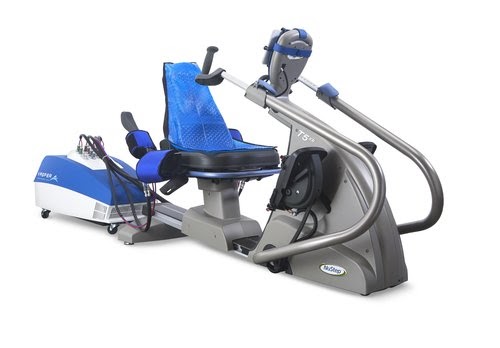“The excellency of every art is its intensity, capable of making all disagreeable evaporate.” – John Keats
As humans, we are a mixed bag of emotional types. Some of us prefer to take things in stride, to pursue tasks or activities in a measured manner, and avoid intense situations and emotions.
Others seem to thrive on intensity. They way they work, play and fight is marked by many periods of intensity and high-energy.
But it’s probably fair to say that when it comes to working out most people tend to default to the “slow and steady” approach. And for good reason. There are a number of exercises and movements that should never be executed quickly or too intensely so as to avoid injury. And intensity should never be confused with grit and determination, which is essential to effective workouts.
But it turns out that there is an effective method for intensity afterall.
Taking a Look at High-Intensity Interval Training (HIIT)
The concept of interval training has been around since the early years of the last century.
High Intensity Interval Training (HIIT) is a typically a regimen of physical training utilizing fast, intense bursts of exercise, followed by brief, less intense intervals. HIIT workouts can be done almost any exercise machine, like bikes, rowers, treadmills, and cross trainers.
The workout intensity is higher and can raise both aerobic and anaerobic stamina while burning fat. Typically, the extreme “sprint” stages of the training can range from 5 seconds up to 8 minutes and are performed at 80 to 95 percent of maximum heart rate.
The goal of the low interval periods is to perform at 40 to 50 percent of a person’s maximum heart rate.
A good description of HIIT can be found at Wikipedia,
“High-intensity interval training (HIIT), also called high-intensity intermittent exercise (HIIE) or sprint interval training (SIT), is a form of interval training, a cardiovascular exercise strategy alternating short periods of intense anaerobic exercise with less intense recovery periods, until too exhausted to continue. Though there is no universal HIIT session duration, these intense workouts typically last under 30 minutes, with times varying based on a participant’s current fitness level. The duration of HIIT also depends on the intensity of the session.”
Speed Play and the Origins of HIIT
Some sources credit the beginnings of HIIT with the work of various coaches and athletes such as Finns Paavo Nurmi and trainer Lauri Pikhala who, around 1910, developed a type of interval training system for their training sessions.
In addition, another Finn, Hannes Kolehmainen, the Finnish Olympic gold medalist trained with a version of interval training.
Around the same time, in the 1930s, Swedish athlete and coach Gustaf “Gösta” Richard Mikael Holmér developed what was known as the fartlek, or “speed play” interval training technique. The technique proved successful and has been adopted by many physiologists since then.
An article in Runner’s World talks about the origins of Fartlek, or Speed Play,
“When Fartlek came along in Sweden in the 1930’s it quickened training worldwide with new strides on new paths, innovative as any idea in athletics’ history: Interval training, the Fosbury Flop. You name it, “Speed Play” is right up there.
That’s “Fartlek” with a capital F, which is how Swedish national coach Gosta Holmer coined it when he pocketed the stopwatch and created something new for the downtrodden Swedish cross country teams which had been thrashed throughout the 1920’s by Paavo Nurmi and the Finns. His concept: faster-than-race-pace, simultaneous speed/endurance training—speed play, in Swedish.”
Fast forward almost a hundred years and you find that the concepts and methods have evolved to become what is now commonly known as high-intensity interval training, or HIIT.
Science, Technology and HIIT
As with many things going into the high tech era, HIIT has been advanced to include previously unavailable technology. Research determined that combining compression and cooling technology to interval training, this type of enhanced workout could deliver the most significant benefits of high-intensity exercise, but in more efficient and low-impact brief workout.
The result was the Vasper Training system that utilizes technology to deliver regulated compression, dynamic cooling of the muscles, and low-impact exercise to create the effect of a high intensity, or anaerobic exercise. And this is accomplished with a fraction of the time, effort, and muscle damage it would take to achieve the same results with conventional exercise.
At the core of this technology is the Vasper low-impact NuStep T5XR platform.

[Image courtesy of Vasper]
According to the Vasper website,
“The reason Vasper uses a NuStep T5XR is to avoid stressing the body and breaking down muscle tissue. The goal with Vasper is to minimally stress the muscles while still triggering a systemic recovery response that can heal damaged or unconditioned areas of the body.”
If you are one of those people, which means “most of us”, that has precious little time for long, involved workouts and exercise regimens, Vasper can be a gift. With the Vasper Training system you can achieve the most significant benefits of high-intensity exercise in an efficient and low-impact 21-minute workout.
One of the great benefits of the Vasper System is that just about anyone can use it.
While there are definitely many professional athletes and other professionals with physically demanding jobs who make use of it on a regular basis, Vasper training can be utilized by “ordinary” people at any physical level of activity.
So, if you are simply looking to recover from an injury, or just want to increase your exercise efficiency, the Vasper System is a great way to achieve it.
We no longer have a Vasper system at our facility, but we encourage or clients and readers to explore systems like Vasper while they pursue their health goals
Contact us today at (707) 636-4404 or use our online booking form to set up a consultation and an office walkthrough.
Our primary goal is to be here for you and to help you achieve a happy and healthy life.